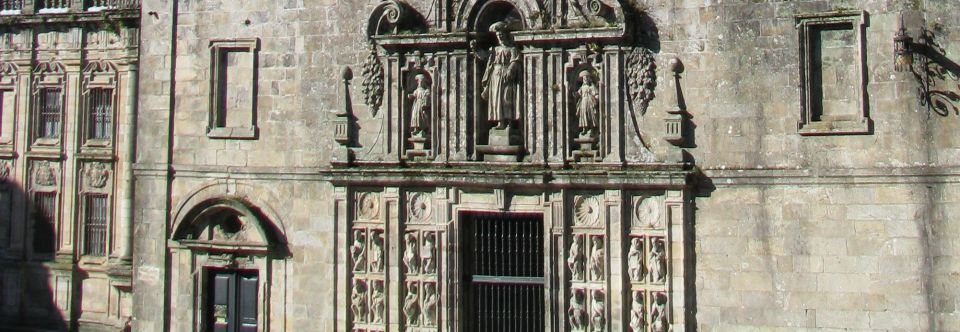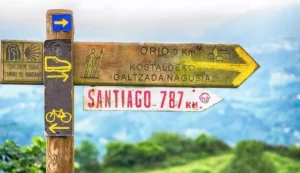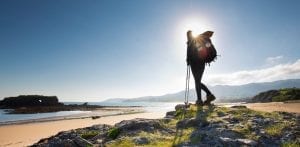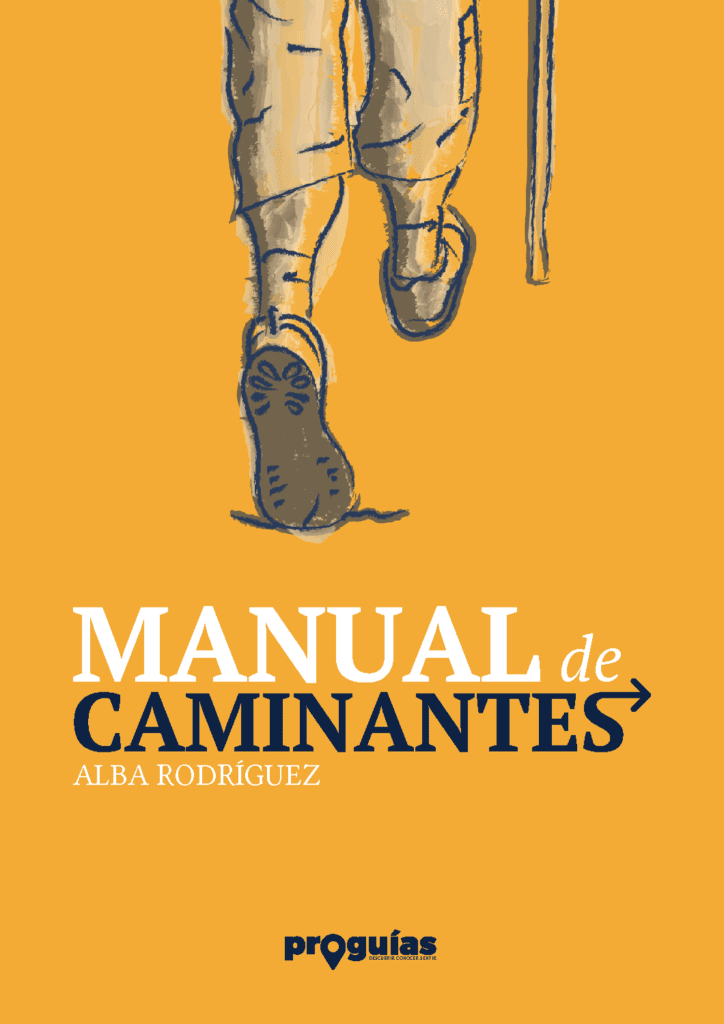You arrive in Santiago after days of pilgrimage and, as it is Holy Year, you decide that the best way to enter the cathedral is to go through the so-called Holy Door. After all, it's one of the most popular rituals, it's not always open and it's worth a try. Chances are you will find a long queue to get in. What's more, sometimes the queue goes all the way around the square, and it discourages anyone. That's why we want to help you with some tips to make your access more comfortable (and faster).
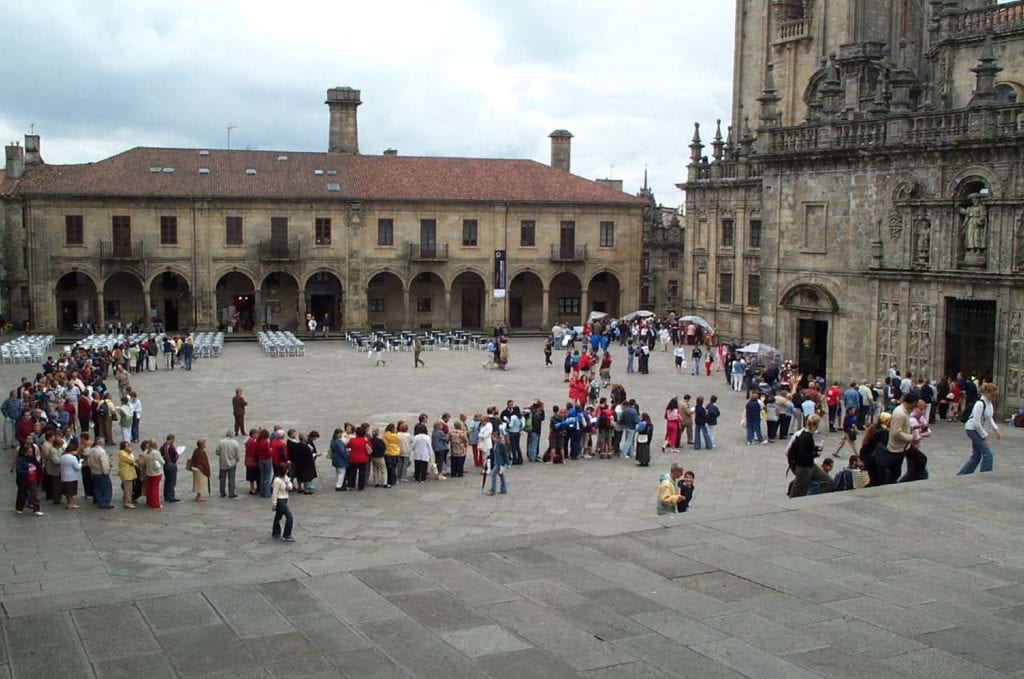
Why the Holy Door?
One of the most symbolic points of the Cathedral of Santiago is, without a doubt, its Holy Door. It is an access from the Quintana Square that opens only in Holy Years. The Compostelan Holy Years occur when the 25th of July, St. James' Day, falls on a Sunday, which happens only 14 times every century, with a cadence of six, five, six and eleven years. Therefore, the Holy Door opens only 14 times every hundred years. And it is quite an event.
For those who walk the Camino with religious significance, the gate serves as a rite of passage. And, in fact, gates appear several times in the Bible. The Gospel of John (10:19), for example, attributes to Jesus the phrase "I am the door; if anyone enters through me, he will be saved". However, one does not have to be religiously motivated to be able to enter through the Compostelan door.
Another important fact. Despite what you will read in many guidebooks and websites, it is not necessary to enter through the Holy Door to gain the plenary indulgences associated with the pilgrimage to Santiago. Really, it is not obligatory. The only thing that the church in Santiago de Compostela requires (you can see it on its website) is to visit the cathedral and participate in the Eucharist "or any other liturgical act", pray an Our Father or the Creed, make a sacramental confession a fortnight before or after the visit to the cathedral and receive Holy Communion. The Holy Door is a symbol, not a requirement.
In any case, we do not know the exact origin of this tradition of the holy doors, which also exists in other places. The most widely accepted theory is that the Compostela ritual arose in the 16th century, at the hands of Archbishop Alonso III de Fonseca, linking it to the tradition of some major Roman basilicas, such as St. Peter in the Vatican, St. John in the Lateran, St. Paul Outside the Walls or St. Mary Major, which also had their holy doors. To do so, he used a minor door in the original Romanesque layout of the cathedral, located between the chapels of the Saviour and St. Peter's, which leads directly to the ambulatory of the cathedral.
With the Baroque remodelling of the Quintana Square, which enclosed the angular forms of the Romanesque apse behind a continuous, rectilinear wall, the Holy Door is accessed through a corridor and through a gate surrounded by sculptures reused from the stone choir by Master Mateo (ca. 1200).
Opening times and access to the cathedral
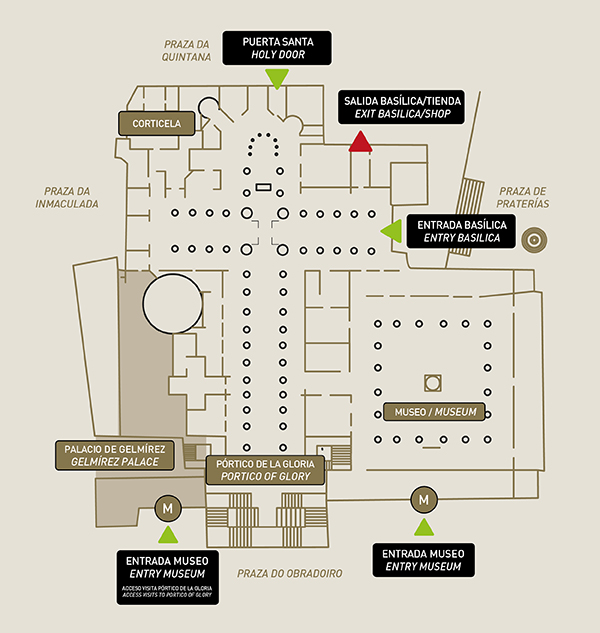
At the time of writing, the cathedral of Santiago is open uninterruptedly from 9 AM to 8.30 PM. Not so long ago it was open from 7 AM, but the pandemic has changed a lot of things and there is no telling when we will be back to normal. Still, 11 and a half hours should be enough time to find a way in.
As for the entrances, the cathedral was traditionally entered through any of its doors (except for the Holy Door, which, as we have already mentioned, is closed except during the Holy Year).
Pilgrims coming along the English Route, the French Route or any other route leading to the latter (the Northern Route, the Primitive Route, the Winter Route or even the Silver Route) used to enter through the Porta Francígena or Azabachería Gate, on the north side of the transept. Those arriving by the Portuguese Way used to do so through Platerías, on the south side. Or through the Obradoiro, up the stairs and through the Pórtico de la Gloria. Today, however, access is much more restricted for security and control reasons.
In convent years, the only fully open entrance is usually the Pratarías entrance. This means that if you approach from the north side, with few exceptions, a friendly security guard will tell you that you have to go around the cathedral and enter from the other side. The same goes for getting out. You will, of course, have to exit through the temple shop, because here nothing happens by accident. The shop has two doors: one leads to the Quintana and the other to Pratarías, under the immense Berenguela Tower.
We take this opportunity to tell you that access to the cathedral is completely free, unlike many others. In fact, free access is a characteristic of pilgrimage churches, which occurs throughout the Camino de Santiago.
Handbook of Pilgrims
Download the most complete guide to prepare the Camino de Santiago from scratch and step by step.
Once inside, freedom of movement is almost total in the conventional years. In the Holy Years, mobility can vary considerably, and the presence of security is quite noticeable. This is especially true during the busiest times of the day. You probably will not be able to move from one part of the temple to another without taking a detour. Nor will you be able to visit the cathedral as a tourist or cultural activity during the main masses, which are those celebrated at the high altar (as a matter of respect).
What does not usually vary are the access and exit points. Simply, the Holy Door opens and you will see many people entering through it, little by little. But that doesn't mean that the south gate, the Praterías gate, is closed. Or that it is compulsory to enter through the Holy Door. Despite what you can read in many guidebooks and websites, it is not.
§ Learn more: Doing the Camino de Santiago. 5 reflections to know if you are ready
How to avoid queues at the Holy Door?
We have already seen why the Holy Door is so important and what the alternatives are. Now let's get down to business: how to enter through it without queuing for more than an hour?
Unfortunately, there is only one option: go at off-peak hours. Let's assume that you visit Compostela between the months of April and September, both included (from October to March there is much less tourism and also fewer pilgrims, and there are almost no queues). If you come in the middle months of the year, the only possibility is to try to get there early in the morning or at lunchtime.
Some guidebooks also suggest late afternoon, but this is not usually a good idea. Although it is true that there are fewer visitors, there is a Pilgrim's Mass at 19.30h and the cathedral closes just after, so it is difficult to get in, since, as we have said, during masses access is very restricted.
What you should avoid are the hours immediately before and after the Pilgrim's Masses, which traditionally were at 12.00h and 19.30h, but which in this Xacobeo are completed with one at 9.30h. At the earlier ones, many people line up at the door to enter and stay for the celebration. In the later ones, people who have wanted to enter and have not been able to do so have formed an endless queue. And things get more complicated on weekends and holidays, when even more masses are celebrated at the main altar - blocking access to those who are not going to participate in them.
That said, the best time to enter without great difficulty is at lunchtime, which in Santiago is around 2pm. This is undoubtedly the least crowded time. The second best option is still at 9am, because the first of the pilgrim's masses of the day is the one that, for the moment, has the least number of people.
Be that as it may, our recommendation is to opt for times with a lower volume of visitors and pilgrims, if you can choose. It makes everything much easier.


